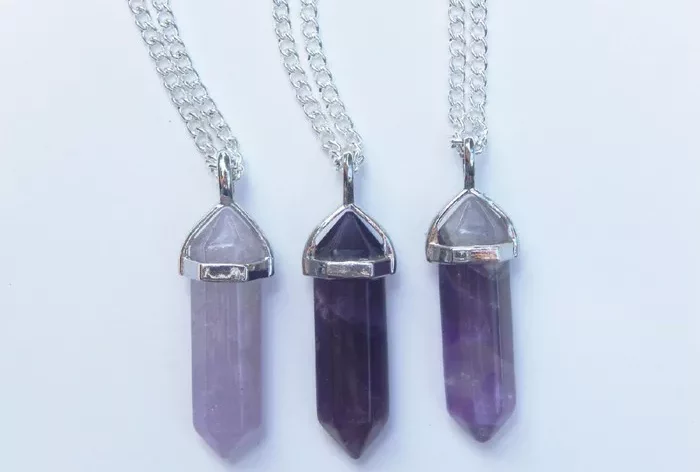In the vast and intriguing world of gemstones, each variety holds its own unique charm and significance. Among these, amethyst and pyrite often catch the eye of collectors and jewelry enthusiasts due to their distinct appearances and properties. While amethyst boasts a captivating violet hue, pyrite, often known as fool’s gold, shines with a metallic, brassy luster. The question arises: how do these two seemingly disparate gemstones coexist in nature, and what do they represent in the realm of jewelry and gemology? This article aims to provide a comprehensive introduction to amethyst and pyrite, exploring their characteristics, how they form together, and their applications in jewelry making.
Characteristics of Amethyst
Color and Appearance
Amethyst is a variety of quartz that displays a rich, violet hue. Its name is derived from the Greek word “amethystos,” meaning “not drunk,” as ancient civilizations believed it could prevent intoxication. The color of amethyst ranges from a light lavender to a deep, royal purple, with some pieces exhibiting zoning—bands of varying color intensity. Its transparency can vary from transparent to translucent, and it often has a vitreous luster.
Formation and Occurrence
Amethyst forms primarily in igneous, metamorphic, and sedimentary rocks. It’s often found in geodes, which are hollow, rounded rock formations with crystals lining their interiors. The presence of trace elements, such as iron and aluminum, and natural radiation play crucial roles in the development of amethyst’s violet color. Geologically, amethyst-bearing deposits are widespread, with notable occurrences in Brazil, Uruguay, Zambia, Madagascar, and the United States.
Hardness and Durability
On the Mohs scale of mineral hardness, amethyst ranks at 7, making it suitable for most jewelry applications. However, its durability can be affected by exposure to heat and certain chemicals, which can alter its color. Proper care and cleaning are essential to maintain its beauty and luster.
Characteristics of Pyrite
Color and Appearance
Pyrite, often mistakenly identified as gold due to its brassy yellow hue and metallic luster, is a sulfide mineral composed of iron and sulfur. Its name is derived from the Greek word “pyr,” meaning “fire,” because it produces sparks when struck with steel. Pyrite crystals can form in various shapes, including cubic, pyramidal, and tabular, with a characteristic striated appearance on their surfaces.
Formation and Occurrence
Pyrite forms in a wide range of geological environments, including igneous, metamorphic, and sedimentary rocks. It’s often associated with volcanic activity and hydrothermal deposits. Pyrite can also form as a replacement mineral within fossilized remains, creating intriguing and scientifically significant specimens. Its widespread occurrence makes it a common find in rock collections and mineral specimens.
Hardness and Durability
Pyrite ranks at 6.5 on the Mohs scale of mineral hardness, making it slightly softer than amethyst. While it’s durable enough for some jewelry applications, pyrite’s brittle nature and susceptibility to tarnishing limit its use. Proper care, including avoiding exposure to moisture and acids, is crucial to preserve its appearance.
Coexistence of Amethyst and Pyrite
Geological Setting
The coexistence of amethyst and pyrite often occurs in geological settings where both minerals can form simultaneously. Igneous and metamorphic rocks, particularly those associated with volcanic or hydrothermal activity, provide the ideal conditions for both minerals to crystallize. In these environments, hot, mineral-laden fluids rise to the surface or fill cavities within rocks, precipitating crystals of amethyst and pyrite as they cool and solidify.
Depositional Processes
Geodes are a classic example of how amethyst and pyrite can coexist. As fluid-filled cavities within rocks cool and crystallize, amethyst forms first, filling the space with its violet quartz crystals. Subsequently, pyrite crystals precipitate within the voids and fractures within the amethyst, creating a striking visual contrast. This sequential deposition process results in geological specimens where amethyst and pyrite are intertwined, showcasing their unique beauty and geological significance.
Mineral Associations
In addition to their geological coexistence, amethyst and pyrite are often found associated with other minerals. For instance, they may occur alongside quartz, calcite, and other sulfide minerals in hydrothermal veins. These associations provide valuable clues to geologists about the origin and evolution of the rocks and minerals within which they are found.
Applications in Jewelry
Design and Aesthetics
The combination of amethyst’s rich violet hue and pyrite’s metallic luster creates a striking visual contrast that jewelry designers often exploit. Amethyst’s translucent nature allows light to pass through, creating a shimmering effect that complements pyrite’s reflective surface. Together, they offer a unique and visually appealing palette for creating distinctive jewelry pieces.
Jewelry Craftsmanship
Creating jewelry from amethyst and pyrite requires skill and precision. Amethyst’s hardness and durability make it suitable for a variety of cutting and polishing techniques, allowing jewelers to create intricate designs. Pyrite, on the other hand, requires careful handling due to its brittleness and susceptibility to tarnishing. Jewelers often treat pyrite surfaces to enhance their luster and protect them from wear and tear.
Popular Jewelry Types
Amethyst and pyrite are frequently used in pendants, earrings, bracelets, and rings. Their unique aesthetic qualities make them perfect for creating bold, statement pieces as well as delicate, everyday jewelry. The contrast between amethyst’s soft, translucent hue and pyrite’s brassy luster adds depth and dimension to jewelry designs, making them stand out in any collection.
Conclusion
The coexistence of amethyst and pyrite in nature is a testament to the intricacies of geological processes. Their unique aesthetic qualities make them a favorite among jewelry designers and collectors. By understanding their characteristics, formation, and care requirements, jewelry enthusiasts can appreciate and maintain the beauty of these captivating gemstones. Whether in geological specimens or intricately crafted jewelry pieces, amethyst and pyrite continue to captivate our imaginations and inspire creativity. Their coexistence serves as a reminder of the intricate and beautiful world we live in, where even the most disparate elements can find harmony and beauty.
Related topic:
- The Relationship between Amethyst and Hematite in Terms of Crystal Structures
- Amethyst and Opal: A Wonderful Encounter of Energy Complementarity
- Amethyst Halo Crystal vs Ordinary Amethyst: What Is the Difference?


